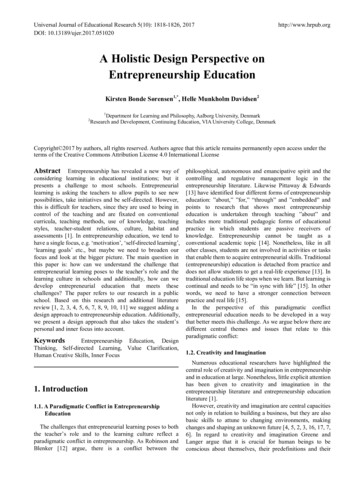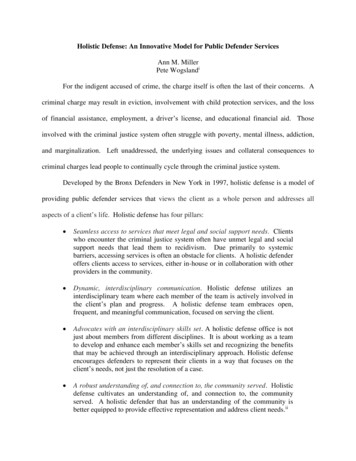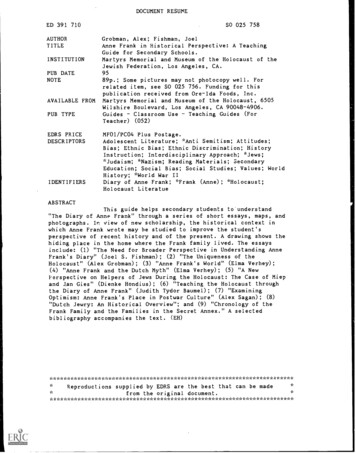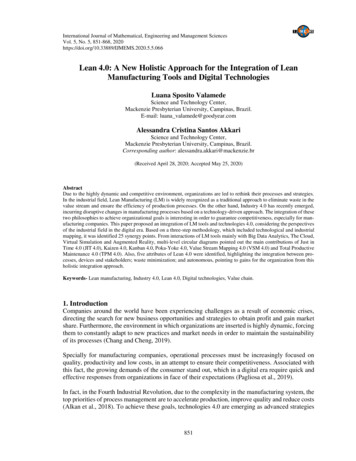
Transcription
Universal Journal of Educational Research 5(10): 1818-1826, 2017DOI: 10.13189/ujer.2017.051020http://www.hrpub.orgA Holistic Design Perspective onEntrepreneurship EducationKirsten Bonde Sørensen1,*, Helle Munkholm Davidsen21Department for Learning and Philosophy, Aalborg University, DenmarkResearch and Development, Continuing Education, VIA University College, Denmark2Copyright 2017 by authors, all rights reserved. Authors agree that this article remains permanently open access under theterms of the Creative Commons Attribution License 4.0 International LicenseAbstractEntrepreneurship has revealed a new way ofconsidering learning in educational institutions; but itpresents a challenge to most schools. Entrepreneuriallearning is asking the teachers to allow pupils to see newpossibilities, take initiatives and be self-directed. However,this is difficult for teachers, since they are used to being incontrol of the teaching and are fixated on conventionalcurricula, teaching methods, use of knowledge, teachingstyles, teacher-student relations, culture, habitat andassessments [1]. In entrepreneurship education, we tend tohave a single focus, e.g. ‘motivation’, ‘self-directed learning’,‘learning goals’ etc., but maybe we need to broaden ourfocus and look at the bigger picture. The main question inthis paper is: how can we understand the challenge thatentrepreneurial learning poses to the teacher’s role and thelearning culture in schools and additionally, how can wedevelop entrepreneurial education that meets thesechallenges? The paper refers to our research in a publicschool. Based on this research and additional literaturereview [1, 2, 3, 4, 5, 6, 7, 8, 9, 10, 11] we suggest adding adesign approach to entrepreneurship education. Additionally,we present a design approach that also takes the student’spersonal and inner focus into account.KeywordsEntrepreneurship Education, DesignThinking, Self-directed Learning, Value Clarification,Human Creative Skills, Inner Focus1. Introduction1.1. A Paradigmatic Conflict in EntrepreneurshipEducationThe challenges that entrepreneurial learning poses to boththe teacher’s role and to the learning culture reflect aparadigmatic conflict in entrepreneurship. As Robinson andBlenker [12] argue, there is a conflict between thephilosophical, autonomous and emancipative spirit and thecontrolling and regulative management logic in theentrepreneurship literature. Likewise Pittaway & Edwards[13] have identified four different forms of entrepreneurshipeducation: ”about,” ”for,” “through” and ”embedded” andpoints to research that shows most entrepreneurshipeducation is undertaken through teaching ”about” andincludes more traditional pedagogic forms of educationalpractice in which students are passive receivers ofknowledge. Entrepreneurship cannot be taught as aconventional academic topic [14]. Nonetheless, like in allother classes, students are not involved in activities or tasksthat enable them to acquire entrepreneurial skills. Traditional(entrepreneurship) education is detached from practice anddoes not allow students to get a real-life experience [13]. Intraditional education life stops when we learn. But learning iscontinual and needs to be “in sync with life” [15]. In otherwords, we need to have a stronger connection betweenpractice and real life [15].In the perspective of this paradigmatic conflictentrepreneurial education needs to be developed in a waythat better meets this challenge. As we argue below there aredifferent central themes and issues that relate to thisparadigmatic conflict:1.2. Creativity and ImaginationNumerous educational researchers have highlighted thecentral role of creativity and imagination in entrepreneurshipand in education at large. Nonetheless, little explicit attentionhas been given to creativity and imagination in theentrepreneurship literature and entrepreneurship educationliterature [1].However, creativity and imagination are central capacitiesnot only in relation to building a business, but they are alsobasic skills to attune to changing environments, makingchanges and shaping an unknown future [4, 5, 2, 3, 16, 17, 7,6]. In regard to creativity and imagination Greene andLanger argue that it is crucial for human beings to beconscious about themselves, their predefinitions and their
Universal Journal of Educational Research 5(10): 1818-1826, 2017mental steering models which enable them to seeopportunities and break with the well-known [3, 16]. ForGreene learning is not about filling students’ brains withknowledge but about helping them to develop the ability tocreate meaning. Likewise, Greene considers education to beabout helping human beings to create themselves. “Identityis never fixed, we are always becoming,” Greene stated [16,17].Although Greene’s theories are several decades old theystill seem utterly relevant, particularly in the perspective ofrecent knowledge about cognition and the possibilities ofcontrolling and changing dominant values and thinkingpatterns [16, 6, 62].1819A design approach or design thinking is also representedin Boland & Collopy s notions ‘design attitude’ versus‘decision attitude’ [20]. The decision attitude rests on theassumption that the difficult task in managing is selectingamong alternatives, whereas a design attitude assumes thatmanaging means to generate and create better alternatives. Inthis sense a design attitude or design thinking focusses on‘what might be’ rather than on ‘what is’. Michlewski hasidentified the qualities included in a design attitude. Theyinclude: empathy, a willingness to embrace ambiguity, thedesire to engage and use one’s senses to learn, exploring andexpressing oneself, an appreciation of complexities that havequalities that go beyond their parts, and an interest in actuallymaking things [25, 26].Design thinking is often described as “ [an] open and1.3. A Broader Focushuman-centred approach to solving problems” [1]. But theApart from creativity and imagination, we also need a application of design approach/design thinking is not limitedbroader perspective in order to better understand and comply to objective problems outside of oneself; it also includeswith the increasing complexity of the world. Most of the subjective issues – regarding value clarification, changes ofprinciples we use in our way of organising and leading our dominant values and, as such, changes in humanorganisations stem from a radically different time. Our development, as described by Sørensen [10, 19, 11]. Dunnebusinesses and organisations – including our educational & Martin [27] emphasise that education based on theinstitutions – are dominated by mental models rooted in rationale of design and design thinking teaches students toIndustrial Scientific Management, which taught us to think in focus on ‘what might be’. Thus, it offers a radically differentlinear cause-and-effect patterns and break down problems approach to the world focussing on imagination, the creationinto parts rather than seeing wholes and connections [18]. of possibilities and an unknown future, which is essential inInstead, we need a more holistic approach and awareness and entrepreneurship [28].a better understanding of all our systems, i.e. systemsIn the field of entrepreneurship, design and designthinking. Systems operate everywhere; the family is a system, thinking have only received scant attention. In this paper wethe school, the playground, every organisation is a system etc. will refer to a recent paper that introduces design thinking in[7].entrepreneurship education represented in the “DesUniIn this paradigmatic conflict, we consider design thinking model” [1]. Nielsen & Storvang s article offers an overallas a parallel to systems thinking, since it offers a holistic argumentation for why and how design thinking hasperspective. Contrary to systems thinking is it not only relevance in entrepreneurship education. In another researchanalytical, but is centred around creativity and imagination, paper (Sørensen & Evers, 2015) design thinking isseeing and actively creating new possibilities. This paper introduced in entrepreneurship as both an objective and apresents design thinking used not only for objective but also subjective activity – which means design thinking is used infor subjective issues [11, 19]. Thus, design thinking offers a 1) value clarification processes – also called transformativeperspective that can be used for the human development that design processes, as they lead to changes in identity andGreene, Langer, Robinson, Goleman & Senge stand for, as behaviour 2) objective processes about the market, potentialwell as for the more market-oriented perspective which is customers, and finally 3) the larger world, which could be acentral in both design and particularly in entrepreneurship bigger purpose, sustainability, circular economy etc. Theseliterature.different foci are interpretations of Goleman & Senge s(2014) notion of the Triple Focus, which refers to an ‘inner’,an ‘other’ and an ‘outer’ focus. We will elaborate on design1.4. Design Thinking – A New Holistic View &processes aimed at value clarification and an ‘inner’ focusPerspectivelater in this article.Design is often seen as a product, but design can alsorepresent the underlying design activity, the design process 1.5. Adding Design Thinking to Entrepreneurshipor design thinking in which both creativity and imaginationEducationare key concepts. In recent years, there has been a growingfocus on design thinking within the business community.The DesUni teaching model offers “a significant paradigmSeveral researchers and practitioners have introduced new shift changing the traditional didactic assumptions ofnotions, methods and theories: design management & design entrepreneurship education. It involves a change inleadership [20, 21], design business modelling [22] and curriculum, teaching methods, use of knowledge, teachingservice design [23, 24]·style, teacher-student relations, culture, habitat and
1820A Holistic Design Perspective on Entrepreneurship Educationassessment” [1].With the DesUni model Nielsen & Storvang [1] offer adetailed account of the relationship between design thinkingand entrepreneurship. With reference to Sarasvathy [29, 30]they argue that entrepreneurship processes are dominated byeffectuation logics rather than causation logics. Effectuationis based on the logic of design, whereas causation processesare based on the logics of prediction, rational analysis,planning and control to reach previously defined effects.Traditional entrepreneurship education typically leanstowards the causational view [30] with entrepreneurshipcourses that are organised around a business plan andmainstream management thinking. Both entrepreneurs anddesigners are creative problem solvers, but they differespecially in terms of focus within the process of opportunityemergence [31]. Design thinking is relevant as it focusses oncreating an unknown future [1].The difference between contemporary entrepreneurshipeducations based on the rationale of causation andentrepreneurship education based on the idea of designthinking is illustrated in Nielsen & Storvang’s figure below[1].Design thinking requires a specific mindset, design actionand experimentation. Likewise, design thinking cannotdevelop without imagination and creativity.1.6. Design Processes and a Design MindsetSarasvathy [29] explains that all entrepreneurs begin withthree categories namely: Who they are, what they know andwhom they know. However, Sarasvathy s theory focuses on‘effectuation’ as an entrepreneurial way of thinking and notso much on a deeper investigation of the personal passions,values and mental models of the entrepreneur. Nor does shetake the significance of empathy, designerly knowledge, oremotional and aesthetic experiences into account unlikeSørensen & Evers [11] who explain ‘designerly andhuman-centred entrepreneurship’.In an interview about entrepreneurship the businessprofessor Steen Hildebrandt argues: “ forget everythingabout the perfect business model dares to embark on aninner journey to find meaning” [32]. Similarly, the creativityprofessor Sir Ken Robinson [4] stresses the importance offinding ‘the element’; Stephen Covey uses the term ‘voices’[33] and psychology professor Kennon Sheldon uses thephrase ‘intrinsic motivation’ and ‘self-determination theory’[34]. Young students, in particular, need to focus onthemselves in order to be aware of their passions, innerstrength and limitations [7]. Greene [3] and Langer [16]highlight the human ability to see and change one’s ownperspective, not only in regard to objective issues, such asnew businesses, but also in relation to one’s own life – whatBlenker et al. call ‘an entrepreneurial mindset’.Yet, this inner perspective has received little attention inthe literature about entrepreneurship education (Blenker et al,2011). However, Blenker et al. [9] identify four differentapproaches or paradigms to entrepreneurship education:three of these refer to the market and creating change in theworld, whereas the last approach refers to the students’ wayof being, in what they call “an entrepreneurial mindset” (ibid,2011, 421), also called ‘transformative processes’ and‘(re)constructions of identity’.In comparison to the DesUni model Nielsen & Storvang [1]argue that the underlying logic of the DesUni model isinspired by Seelig who “suggests considering both internaland external processes in the student in order to boosttransformative changes in students” [1]. The authors claimthat the DesUni model includes “a design mindset” and “apedagogical dimension of the teaching model that assiststeachers in bringing out the desired change in the student”(ibid, 982). Yet, the article does not offer a more in-depthexplanation of these “transformative changes.”Figure 1. Design thinking and entrepreneurship education (Nielsen & Storvand, 2015, 980)
Universal Journal of Educational Research 5(10): 1818-1826, 2017Blenker et al. have identified four paradigms, heredescribed with additional questions related to an educationalsetting:1) Training students to create new ventures – How dowe train students to start new ventures?2) Training students to transform ideas and knowledgeinto economic growth – How do we train students tocreate high-growth firms?3) Facilitating entrepreneurial energy for social change– How do we train students to create high-growthfirms?4) Facilitating entrepreneurship as an everyday practice– How do we install an entrepreneurial spirit instudents?Blenker et al. argue that we need an alternative approachthat focusses on “building up entrepreneurship as avalue-creating meta-competence, ‘an entrepreneurialmindset’, which can be applied in multiple walks of life andnot only in starting a business, becomes a matter ofparamount importance” (ibid, 423).The authors consider entrepreneurship to be an everydaypractice “prior to all other forms of entrepreneurial activity”(ibid, 423). Despite the authors’ focus on business-orientedvalues, since they believe that this ‘entrepreneurship mindset’will lead to “more enterprising and competitive individualsand organizations,” we see many parallels to the morephilosophical and human-centred researchers introducedpreviously: Langer, Greene and Robinson. In particular, wepay attention to Blenker et al.’s definition of theentrepreneurship mindset and the construction andreconstruction of identity and transformation throughimagination. This is very much in line with Greene sperception of human beings: “We are always becoming” andher saying: “I am what I am not yet” [36]. Likewise, it pointsto the human capacity to change one’s perspective in relationto one’s own life, which is extremely relevant [2, 3, 35, 4, 5,8].Blenker et al. claim that it is very easy to get locked into aparticular identity, both professionally and personally, andthey present ‘imagination’ as a core competency in theentrepreneurial mindset. This mindset “ comes into beingthrough interplay between narratives and storytelling.” Thisagain influences how the individual constructs or reconstructhis or her identity. As such the authors consider narratives tocontribute to the creation of opportunities and identity. “Theaim of including storytelling and narratives as part of theentrepreneurship curriculum is to enable students to perceivetheir own world as one filled with opportunities that originatewithin themselves and reflect on how this affects their abilityto act.” Using narratives and storytelling is nothing new, theauthors claim (ibid, 434).1.7. Design Processes Aimed at the Inner Focus andSelf-leadershipTraditionally, design and design thinking are considered a1821new approach to problem solving [1], indicating something‘outside’ oneself which needs to be solved, changed etc. Inmore recent design research design processes are also used inrelation to subjects, as a meta-cognitive perspective that canhelp you to ‘see’ your dominant values and change them [10,19]. Thus, design thinking and design processes can be usedin the creation and recreation or ‘reframing’ [35, 36, 37, 40]of identity, which is demonstrated in value clarificationworkshops.Figure 2. Strategic and transformative design processes focusing onobjective or subjective problems or possibilities (illustration is created bythe authors)Value clarification workshops originate in a doctoraldesign research project [10]. Customers and potentialcustomers in a bank were invited to reflect on and possiblychange their money behaviour. The majority changed theirmoney behaviour in accordance with their ‘real’ personalvalues. An example was a young student who stated she hadchanged her money behaviour and her understanding ofherself: "I realized that I could not be a 'big spender' being astudent" which demonstrates a change in her self-perceptionand identity. In the doctoral research these design processeswere explained in the perspective of self-leadership [41, 42,and Thought-Self-Leadership [43, 10, 44]. The key conceptis that men and women can exert influence on themselves tocontrol their own thinking and actions. These designprocesses can also be seen in the perspective oftransformative learning processes [45, 46, 11].The method has also been tested among entrepreneurs.The value workshops can be seen as ‘an inner journey’. Theyare offered as part of a Danish entrepreneurial initiative(Iværk at Spinderihallerne, Vejle) for creative entrepreneursin order to stimulate reflection on their own skills and humanresources and to reveal dreams and passions. Likewise, theyreveal barriers and inappropriate dominant mental models,
1822A Holistic Design Perspective on Entrepreneurship Educationsuch as ‘I hate selling’, which is an unpopular activity amongcreative entrepreneurs.The creative process integrated in these creative valueclarification workshops includes working with materials, asthis is a special designerly way of ‘thinking with your hands’.In the field of design, generative tools are used as thinkingtools or ‘making tools’, and they have a strong appeal to ourvisual ways of sensing and expressing ourselves. Generativedesign processes appeal to our tacit and unconsciousknowledge, our feelings and dreams [47, 48]. Here they areused as “a language for self-dialogue aimed at the creativityof the individual” [10, 19].An example from the workshops with entrepreneurs:When participants become aware of their current dominantvalues they also ‘see’ their dominant values in what theymodel. At that moment they need to choose: They cancontinue living as they used to, now being (more) aware oftheir dominant values, or they can interpret their values,perhaps even identify new values, to work on ‘implementing’them in their thinking and behaviour. Thus, by ‘seeing’ theirdominant values, they are urged to reframe their perceptionof themselves by doing design – like an artist who used to seeherself as ‘a passive artist’. She did not ‘need to sell her art’because her dominant value from the art scene was: ‘artshould sell itself’. She changed or reframed herunderstanding of herself into ‘a proactive entrepreneur’,showing leadership and developing new types of proactiveselling activities as part of her business strategy.Drawing on Revans [49] and Zuber-Skerrit [50] thisparticular kind of action research – or action learning ortransformative learning [45, 46] – aims at technical andpractical improvements for the participants’ transformedconsciousness about themselves and their business. Thismotivates and empowers them to change themselves and/ortheir firm’s existing boundaries, conditions and, in particular,their ability to see and create possibilities and how to makechoices.2. Research MethodologyBased on our research into ways to integrate a moredesignerly and entrepreneurial approach in elementaryeducation for both teachers and pupils, we have developedand conducted this research:A qualitative research approach was used in the study,which was conducted at a public school in the city of Odense,Denmark. Methodologically we combined design thinking[37, 51, 52 38] and design processes aimed at valueclarification [10] with Design-based Research [53]. The aimof Design-based Research is to create a research designwhich can investigate theoretical hypotheses and while alsodevelop prototypes that can be used in the educationalsystem.2.1. Main Research QuestionsIn entrepreneurship education we tend to focus on singlesubjects such as the students, the students’ motivation,self-directed learning etc. We argue that we need to lookcritically at the bigger picture, asking the research question:How can we understand the challenge that entrepreneuriallearning poses to the teacher’s role and the learning culture inschools? And additionally, how can we developentrepreneurship education that meets these challenges?2.2. Theoretical Research HypothesesOur theoretical research hypotheses were:a) We will support the pupils motivation for learningand influence them and their learning by makingtheir values and choices more visible through designthinking and design activities.b) We will support teachers in seeing and presentingsubject matters as numerous opportunities forlearning through design thinking and visualisation.To investigate our hypotheses we:a) offered the students different design processes,including generative tools, as a more direct access to- and an understanding of - their own values [10, 44,54].b) redesigned or reframed [38] subject matters intodifferent types of learning roles that presented newpossibilities from which the pupils and the teacherscould learn and choose.Design processes represent a distinct mode of knowingand reflecting [52, 55, 38]. ‘Designerly ways of knowing’[51] or ‘designerly’ represent methodologies or issuesspecific to design. A design process represents a higher ion-in-action’) [39]- a reflection that includes‘thinking with the hands’ [56, 61].Design processes often incorporate 'various types of propsand materials in order to stimulate this type of reflection.Some of them are referred to as generative tools, also knownas ‘thinking tools’. The basic assumption of the study is thatoffering students design thinking as a kind of visual-makinglanguage presents the opportunity for reflection on valuesand also on the subject matters for interpretation. It is noteasy, particularly for elementary school students, to identifywhat matters to them, or find new ways of learning on theirown. Therefore, our hypothesis is that these design thinkingprocesses, visual making and doing processes can supportself-directedness and self-leadership [19] also in students learning situations.
Universal Journal of Educational Research 5(10): 1818-1826, 20171823the world and speaking with others.Figure 4.Figure 3. Two examples of students ‘collages illustrating both ‘a good dayat school’ (left) and ‘a less good day at school’ (right side of page)2.3. Research DesignIn our workshops the students were given variousgenerative design exercises that made them reflect onlearning, school, being a pupil etc. One of the exercises wasto illustrate themselves on ‘a good day at school’ and writefive things or situations that contributed to ‘a good day’, suchas ‘a good packed lunch’ or ‘a fun game in the schoolyard’.The next exercise was to indicate the person(s) whowas/were the reason for, or involved in, the situation, e.g.‘my mother made my packed lunch’, or ‘my classmates werepart of the fun game in the schoolyard’ etc. Finally, we askedwhether or not the students found that they had an influenceon these different situations. ‘No influence or little influence’involved adding a red dot, and ‘influence or some influence’involved adding a green dot.In this workshop the students were also presented with ourlearning programme that included four different learningroles offering very different assignments to choose from. Thedifferent learning roles supported teachers and students ininterpreting the same learning objective in different ways.Seeing subject matters from various perspectives is a centralelement in design thinking [39, 38]. Our study offered fourwell-known ways of getting to know the world as learningroles: investigating the world, sensing the world, exploringIllustration of the four different learning rolesThese roles were a key element in a learning programmeabout the Swedish children’s author, Astrid Lindgren. Thecentral learning objective of the programme was the‘interpretation of literary texts’, and this objective wasdivided into more specific learning goals such as ‘analysingthe persons in the novel’. Thus, the students were offeredfour different tasks that related to each learning goal, andthey would all become familiar with that same learning goal,but in different ways.In this learning programme the students were gaining thefreedom to choose how to learn, the opportunity to reflect ontheir preferences for a learning role, and also the reason whythey preferred or felt a stronger motivation for choosing onelearning role over another. Moreover, the students werewelcome to develop their own assignment, which providesthe ultimate opportunity and goal: that the students make thematerial meaningful to themselves [16].After the six weeks learning programme the creativeworkshop was repeated including the same assignments.3. ResultsInformation gathered from two classes included data fromthe ‘before’ and ‘after’ workshop, observations from the sixweeks programme and interviews with teachers. The dataindicated a clear pattern that the pupils were very happy tohave the opportunity to choose, and they were generally ableto engage in a more active way of learning. However,reflecting on their own values and learning preferencesseemed to be difficult for them. Our conclusions were:3.1. Theoretical Research HypothesesOur theoretical research hypotheses were:a) students feel they have influence on various issues intheir lives and at school, yet not on the teachingb) it is difficult for students to reflect on learning andtherefore difficult to see their own values andmotivation for learningc) having choices seemed to stimulate the students’motivation for learning significantlyd) teachers have difficulties leaving the traditionalleading teacher role and did not engage in thelearning processese) teachers have difficulties reframing the learninggoals
1824A Holistic Design Perspective on Entrepreneurship EducationFew of the students demonstrated a high degree ofreflection and responsibility, independence and persistence,and a majority demonstrated only a relatively high degree ofreflection about their learning, which we consider to be thefirst step to self-directed learning prior to taking leadershipand responsibility. According to Knowles, self-directedlearning ‘ describes a process by which individuals takethe initiative, without the assistance of others, in diagnosingtheir learning needs, formulating learning goals, identifyhuman and material resources for learning, choosing andimplementing appropriate learning strategies, andevaluating learning outcomes”[57].The critical dimension in self-directed learning is thelearner s active control of the learning process.Our research study in a public school revealed that pupilsare far from self-directed; rather they feel detached fromlearning and schools. Seen from the pupils perspectiveteachers and principals are controlling their learning. Weconsider this to be the reason why students do not connectpersonal values to learning. As soon as the pupils havechoices and opportunities to select from they do becomeactively engaged in the learning processes.Our interviews with teachers revealed in particular twointeresting issues: We see two basic, but paramountproblems: Teachers are very much in control and are guidingthe students. The goal for the specific lesson leavesno room for flexibility (due to new demands aboutlearning goals). According to the teachers theiroverall motivation and purpose have shifted from“when I can see the students’ growth” to “the grades,they are our bottom line,” which represents a purposeof “meeting the overall demands for me as anemployee.” We laid out a proposal for a new way of teaching: theteachers would be asked to take the students’ interestinto account and understand their resources andpreferences. They would need to take on a new rolewithout controlling the students’ learning and theoutcome of the lesson. This presented a realchallenge to them.Our overall conclusion is therefore that we tend to focuson the students, the students motivation and self-directedlearning in entrepreneurship education as well, but we alsoneed to look critically at the bigger picture. Thisparadigmatic conflict results in various specific andchallenging issues, like the teacher’s role and the learningculture that again influences the students motivatio
professor Sir Ken Robinson [4] stresses the importance of finding ‘the element’; Stephen Covey uses the term ‘voices’ [33] and psychology professor Kennon Sheldon uses the phrase ‘intrinsic motivation’ and ‘self-determination theo











